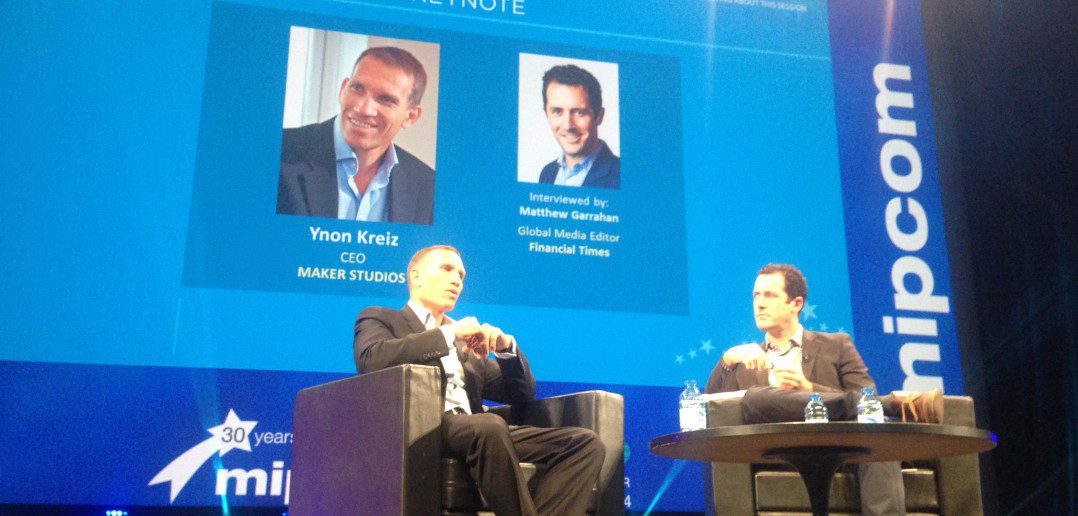Ynon Kreiz, CEO, Maker Studios, left; and moderator Matthew Garrahan, global media editor, Financial Times.
Maker Studios, acquired by The Walt Disney Company last May, enjoys over 9 billion monthly views from 550 million global subscribers, making it the leading online video content network for Millennials. Its offerings span 23 curated vertical genres, which includes content from top digital and traditional stars, along with the most-watched short-form content in online video. Its network comprises 55,000 creators.
CEO Ynon Kreiz has also been around the block. Before Maker, he was chairman/CEO of Endemol; and before that, a general partner at Balderton Capital. He also co-founded Fox Kids Europe NV, where he served as chairman and CEO. Far from being a digital guy with pure new-school roots, he knows his way around the industry.
“Consumption habits are changing rapidly,” Kreiz began this afternoon. We’re seeing “a massive shift from linear TV to online video in general, and short-form in particular.”
What began as a “phenomenon of self-expression — user-generated content, grandmother doing somersaults — is now mainstream, a real business,” said Kreiz. This is especially true for the Millennial generation, aged roughly 14-34.
Per surveys, 12-24-year-olds watch 1/3 less linear TV than adults aged 25-49, and less than half of what adults 50-65 watch. “It’s not that they watch more as they grow older, but that they watch less as they grow younger,” said Kreiz, meaning Maker Studio’s position as category owner of short-form video is even more crucial.
“A lot of people make the mistake and say short-form is like long-form, but shorter,” Kreiz mused. “Short-form is a medium, and the way you produce it, consume it, monetise it, market it and share it is as different from TV as TV is from movies.”
And short-form is getting shorter. Of the top 100 video properties in America, the average video duration is less than four minutes—25% lower than last year, when it was over 5 minutes. That doesn’t even include mobile.
Millennials also have more choices than previous generations. They control their viewing habits from beginning to end, and watch 50% more online videos than any other user. “Gone are the days when you can tell people what to watch and when,” said Kreiz, sounding less-than-sorry.
Enter Maker Studios, whose content includes a short-form series called Epic Rap Battles. The video below features the Teenage Mutant Ninja turtles… and the historical figures from whom they borrowed their names.
This video alone has enjoyed over 30m views, and the series itself has been viewed more than 2bn times, challenging the vast majority of series in television, Kreiz pointed out.
All of that is linked to Maker’s unique DNA: That of a studio created by creators, like the maverick filmmakers who, once upon a time, fled conformity and gave us Hollywood.
“Many creators start small but grow very fast,” said Kreiz. “Some mature and become global phenomenons. Some have subscribers the size of countries.” Case in point: PewDiePie, a Swedish creator whose lets users accompany him through various types of multiplayer video games, then makes videos around what happens.
PewDiePie “started his channel out of his girlfriend’s bedroom in Italy, and is now the single largest YouTube star today: 30m subscribers generating over 450m views per month,” boasted Kreiz.
Asked by Garrahan how the relationship with the Walt Disney Company developed, Kreiz was both pragmatic and frank. “For Disney, the opportunity was to extend their business into short-form, where Maker reaches over 9bn views per month,” he said. Maker wanted to extend “into traditional media and leverage the global resources of the Walt Disney Company”—its assets and salesforces.
“That combination of the no. 1 media company in the world, and the largest short-form online internet company, is a powerful match that will have a huge impact on this market,” Kreiz said, pointing out that according to comScore, Maker and Disney come in just behind Google and Facebook (presumably in terms of monthly traffic).
Gallahan, however, pointed out that advertising costs-per-thousand-impressions (CPMs) still don’t stack up favourably against linear TV CPMs.
“The CPM we get is higher than TV, which is a challenge,” Kreiz defended, “but this is still a nascent industry.”
He went on, “We’re in the business of creating expression, then monetising it. It’s still behind TV, but growth is staggering —double digits at this stage. A lot of credit goes to YouTube, which created what is effectively the largest cable company in the world, driven by Google, with a salesforce of over 20,000 people monetising it.”
There are different ways to monetise media expression: ad sales, sponsorship, and branded entertainment. Maker’s approach to the latter is “high-value but high-touch production,” said Kreiz. “We created our own platform, leveraging our technology to build a marketplace that unites advertisers with our creators network.”
In practical terms, an advertiser working with Maker Studios provides assets to the creators she wants to work with (logos, footage, graphics). “The creators use their own imagination and creative freedom to express what they think would be cool, relevant advertising for millennials,” Kreiz said.
To wit, the following is a Maker Studios creation for Burger King:
“You’d pay hundreds of thousands of dollars or more to create something relevant” in exchange for maybe one or two pieces of advertising, Kreiz said. “Here we have the network to create multiple pieces. They’re quirky, but they connect. This is the art: combining technology with art and science to reach and engage with your audience.”
There are two challenges that plague independent production companies today, according to Kreiz. The first is to stay relevant. He believes they must “leverage their creativity and adjust it to this new medium. It’s not easy because it’s a different form factor; you can’t make the mistake of assuming something worked on TV so you can apply it here.”
The other challenge? Scale. “Maker is an online company.,” said Kreiz. This isn’t because they distribute online versus over-the-air content; “it’s about the values and attributes you derive from the internet,” he clarified.
“We invest heavily in technology; our second-largest workforce is in tech, just behind content. We process over 2 billion rows of data to make programmatic decisions to drive and engage audiences at scientific level. You can only do that when you reach critical mass and have enough scale and size to invest heavily, and also have a real representation of the marketplace.
But for seducing Millennials, what it comes down to is content. Kreiz laughed at how trite that sounded, but emphasised the truth in it.
“How do you create and aggregate great content that they want to watch?” he demanded. “How do you drive, distribute and monetise it in a way that’s commercially viable?”
Maker Studios appears to have found its answer to those questions, but every business, he implied, will need to find their own.




